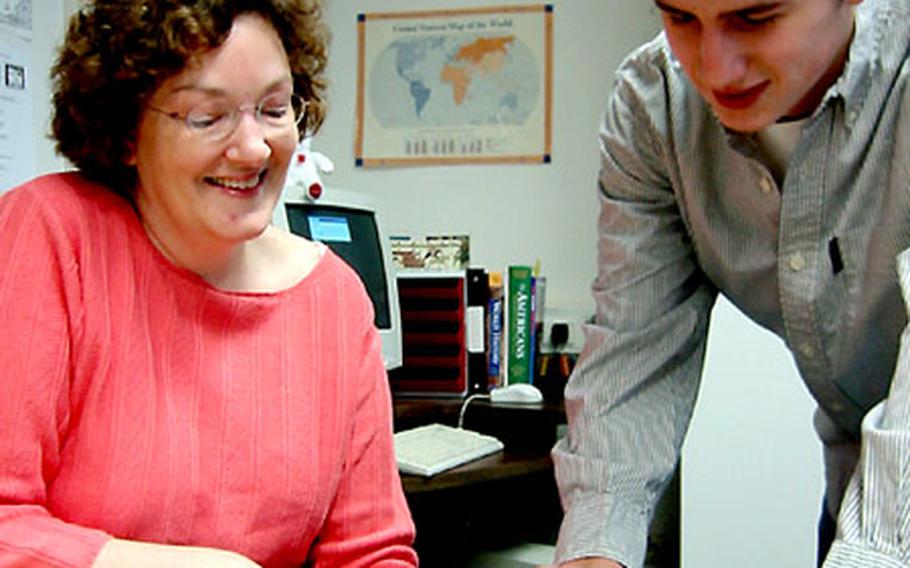
Chris Putko, a senior at Gen. H.H. Arnold High School in Wiesbaden, Germany, looks over an article on foreign policy with teacher Millie Harris, a sponsor of the school's Model United Nations program. (Donald Seltzer / Special to S&S)
THE HAGUE, Netherlands — A pane of bulletproof glass stretching from floor to ceiling separates Slobodan Milosevic and the court from the gallery.
Watching the protracted proceedings is like gazing into a fishbowl. Between the glass and courtroom minutiae, minds have a way of wandering.
Does Milosevic look like a goon or a guppy? Will the Butcher of Belgrade sink or swim? Will he flip on his friends or slip through the net?
“I can tell you it’s a fair trial,” said Slavoljub Caric, consul for the Serbia-Montenegro Embassy in The Hague.
It’s also open to the public, affording a unique opportunity to glimpse a landmark case as it unfolds. The case against the former Yugoslav leader should continue through the end of the year, and probably much, if not all, of the next, according to court observers.
Earlier this year, some teens attending the annual The Hague International Model United Nations dropped by the courthouse near the Congress Centre to watch the trial. One of the teachers who encouraged her students was Millie Harris of Gen. H.H. Arnold High School in Wiesbaden, Germany.
“These are kids who keep up with current events,” Harris said. “They know who he is.”
For some students attending the Model United Nations, going to the Milosevic trial was the highlight of the week. Nearly all of the 21 students from Wiesbaden took the short walk from the conference center to the courthouse to see Milosevic in the dock that first day.
Harris recalled how some students stayed for an hour or two and, later, spoke of little else over dinner that first night.
“It was obviously an impressionable experience,” said Chris Putko, a Wiesbaden high school senior.
Putko wondered aloud if Milosevic and other members of the court could see the gallery through the glass wall. They can. It was a common question students posed to the U.N. guards standing nearby.
“We have a lot of kids whose parents have been to Kosovo and Bosnia,” Harris said, referring to Wiesbaden, home of the 1st Armored Division. The courtroom “brings it together for them. This is the guy,” she said.
The International Criminal Tribunal for the former Yugoslavia has outstanding indictments against 23 suspected war criminals, most notably Bosnian Serb leader Radovan Karadzic and his military commander, Gen. Ratko Mladic.
Since May 1996, when the first defendant, Dusan Tadic, a Bosnian Serb, went on trial, more than 80 people have walked into a tribunal courtroom to face the music. Three individuals died before their day in court, several have been exonerated, more than a dozen defendants have been convicted and more than 50 individuals are under some form of custody, awaiting or in trial.
But none is as big a fish as Milosevic.
“The thing that struck me was his composure and his nonchalance towards the proceedings,” Putko said.
Milosevic comes to court in tailored suits, sporting a stylish Patek Philippe wristwatch. For a man known as the Butcher of Belgrade, Milosevic strikes a seemingly relaxed and dignified pose.
“He looks extremely intelligent,” Putko said, “but there’s a difference, albeit a fine difference, between intelligence and madness.”
Nicole Vanderlinden, a high school junior from Hanau, Germany, said it was odd “sitting in the same room with a man who did so many awful things.”
“You really begin to realize how different everybody is and how morals differ from culture to culture,” she said.
Like Putko, Vanderlinden was struck by how normal Milosevic seemed.
Vanderlinden, five of her Hanau classmates and a chaperon didn’t go to the trial until later in the week. They spent about 45 minutes in the courtroom, watching a prosecution witness give testimony against Milosevic.
“It was like reading a book and starting halfway into it,” she said of trying to grasp the meaning and significance of the man’s testimony.
It took Vanderlinden a few minutes to ascertain which man on the other side of the pane was Milosevic. Between the secret witness, the stoic demeanor of the court, the bulletproof glass and the dark curtains — drawn when the court adjourns for a break — the whole setting seemed surreal, yet sobering.
“You don’t have to comprehend a whole lot to understand the magnitude of the situation,” Vanderlinden said.
When court is in session, the gallery is open free of charge to the general public, though officials consider the age of the person wanting to attend.
After clearing two metal-detector stations, visitors may watch one of three trials occurring at the same time.
The Milosevic trial takes place in Courtroom 1. The setting looks small, but the courtroom can seat about 130 people. Courtroom dialogue is translated into several languages and played over portable audio systems that are available for use.
Vanderlinden found the trial fascinating, but felt at times like an interloper, given the two worlds divided by that glass wall.
“You know when you go to a zoo and all the animals are caged in?” Vanderlinden asked. “That’s what it seems like.”
Milosevic would probably echo that sentiment.